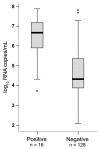Poor clinical sensitivity of rapid antigen test for influenza A pandemic (H1N1) 2009 virus
- PMID: 19861069
- PMCID: PMC2866420
- DOI: 10.3201/eid1510.091186
Poor clinical sensitivity of rapid antigen test for influenza A pandemic (H1N1) 2009 virus
Abstract
Influenza A pandemic (H1N1) 2009 virus RNA was detected by reverse transcription-PCR in 144 clinical samples from Bonn, Germany. A common rapid antigen-based test detected the virus in only 11.1% of these samples. The paramount feature of rapid test-positive samples was high virus concentration. Antigen-based rapid tests appear unsuitable for virologic diagnostics in the current pandemic.
Figures

Comment in
-
Rapid antigen test for pandemic (H1N1) 2009 virus.Emerg Infect Dis. 2010 May;16(5):897-8; author reply 898. doi: 10.3201/eid1605.091574. Emerg Infect Dis. 2010. PMID: 20409404 Free PMC article. No abstract available.
Similar articles
-
Rapid influenza antigen test for diagnosis of pandemic (H1N1) 2009.Emerg Infect Dis. 2010 May;16(5):824-6. doi: 10.3201/eid1605.091797. Emerg Infect Dis. 2010. PMID: 20409373 Free PMC article.
-
Rapid antigen tests for diagnosis of pandemic (Swine) influenza A/H1N1.Clin Infect Dis. 2009 Oct 1;49(7):1090-3. doi: 10.1086/644743. Clin Infect Dis. 2009. PMID: 19725784 Free PMC article.
-
Evaluation of new rapid antigen test for detection of pandemic influenza A/H1N1 2009 virus.J Clin Microbiol. 2010 Jun;48(6):2260-2. doi: 10.1128/JCM.02392-09. Epub 2010 Mar 31. J Clin Microbiol. 2010. PMID: 20357213 Free PMC article.
-
Diagnostic tests for influenza infection.Curr Opin Pediatr. 2011 Feb;23(1):91-7. doi: 10.1097/MOP.0b013e328341ebd9. Curr Opin Pediatr. 2011. PMID: 21150446 Review.
-
Tools to detect influenza virus.Yonsei Med J. 2013 May 1;54(3):560-6. doi: 10.3349/ymj.2013.54.3.560. Yonsei Med J. 2013. PMID: 23549796 Free PMC article. Review.
Cited by
-
A new antigen test device for rapid influenza A and B detection.Heliyon. 2024 Jul 2;10(13):e33979. doi: 10.1016/j.heliyon.2024.e33979. eCollection 2024 Jul 15. Heliyon. 2024. PMID: 39055805 Free PMC article.
-
Diagnostic value of routine blood tests in differentiating between SARS-CoV-2, influenza A, and RSV infections in hospitalized children: a retrospective study.BMC Pediatr. 2024 May 13;24(1):328. doi: 10.1186/s12887-024-04822-y. BMC Pediatr. 2024. PMID: 38741033 Free PMC article.
-
Sensitivity and specificity of in vitro diagnostic device used for influenza rapid test in Taiwan.J Food Drug Anal. 2013 Oct 6;22(2):279-284. doi: 10.1016/j.jfda.2013.09.011. eCollection 2014. J Food Drug Anal. 2013. PMID: 38620156 Free PMC article.
-
The convergent evolution of influenza A virus: Implications, therapeutic strategies and what we need to know.Curr Res Microb Sci. 2023 Sep 7;5:100202. doi: 10.1016/j.crmicr.2023.100202. eCollection 2023. Curr Res Microb Sci. 2023. PMID: 37700857 Free PMC article.
-
Border Control for Infectious Respiratory Disease Pandemics: A Modelling Study for H1N1 and Four Strains of SARS-CoV-2.Viruses. 2023 Apr 16;15(4):978. doi: 10.3390/v15040978. Viruses. 2023. PMID: 37112958 Free PMC article.
References
-
- World Health Organization. Influenza A(H1N1)—update 59 [cited 2009 Jul 31]. Available from http://www.who.int/csr/don/2009_07_27/en/index.html
-
- Robert Koch Institute. Influenza A(H1N1)—Situationseinschätzung zur Neuen Influenza [cited 2009 Jul 31]. Available from http://www.rki.de/cln_160/nn_200120/DE/Content/InfAZ/I/Influenza/IPV/Sch...
Publication types
MeSH terms
Substances
LinkOut - more resources
Full Text Sources
Other Literature Sources
Medical
